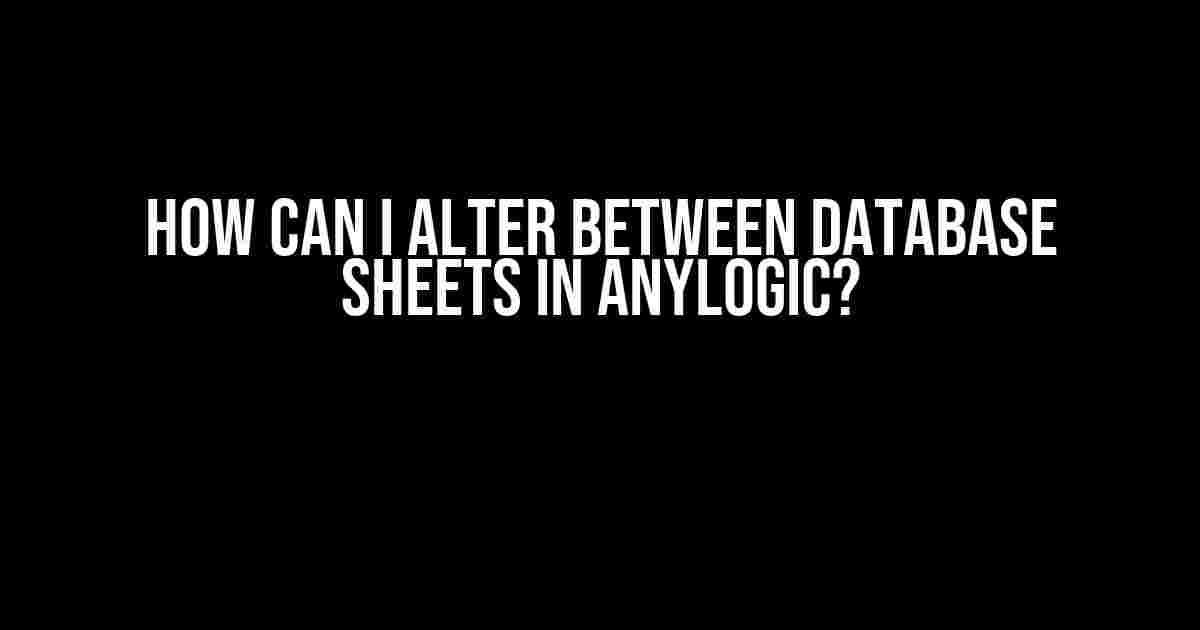Are you stuck in the world of database sheets in AnyLogic, wondering how to seamlessly switch between them? Well, wonder no more! In this comprehensive guide, we’ll take you on a journey to explore the ways to alter between database sheets in AnyLogic, covering the what, why, and how of this crucial skill.
Why Alter Between Database Sheets?
Before we dive into the nitty-gritty, let’s understand the importance of altering between database sheets. AnyLogic is a powerful simulation modeling tool that enables you to create complex models, but it’s only as good as the data that fuels it. Sometimes, you need to switch between different sheets to access specific data or perform particular operations. This is where altering between database sheets comes into play.
By mastering this skill, you’ll be able to:
- Efficiently manage large datasets across multiple sheets
- Perform complex data operations and analyses
- Create more accurate and realistic simulations
- Save time and reduce errors
Prerequisites
Before we proceed, make sure you have:
- Basic knowledge of AnyLogic and its interface
- Familiarity with database concepts and SQL
- A working AnyLogic model with multiple database sheets
Alter Between Database Sheets Using AnyLogic’s Built-in Features
AnyLogic provides several ways to alter between database sheets, and we’ll explore each method in detail.
Method 1: Using the Database Navigation Panel
The Database Navigation Panel is a convenient way to switch between sheets. To access it:
- Open your AnyLogic model and navigate to the
Databasesection - Click on the
Navigation Panelbutton in the top-left corner - Select the desired sheet from the drop-down list
This method allows you to quickly switch between sheets, but it’s limited to sheets within the same database.
Method 2: Using the SQL Query
For more advanced users, SQL queries provide a powerful way to switch between sheets. You can use the USE statement to specify the desired sheet:
USE <sheet_name>
Replace <sheet_name> with the actual name of the sheet you want to switch to. For example:
USE customers
This method offers more flexibility, as you can execute complex queries and switch between sheets across different databases.
Method 3: Using AnyLogic’s API
AnyLogic provides a comprehensive API that allows you to programmatically interact with the database. You can use Java or AnyLogic’s internal scripting language to switch between sheets:
Engine engine = getEngine();
Database db = engine.getDatabase();
db.setActiveSheet("customers");
This method offers the most flexibility, as you can integrate it with your model’s logic and perform complex operations.
Best Practices and Tips
When altering between database sheets, keep the following best practices in mind:
- Use clear and descriptive sheet names to avoid confusion
- Organize your sheets in a logical and hierarchical structure
- Use SQL queries to perform data operations on specific sheets
- Regularly backup your database to prevent data loss
Common Errors and Troubleshooting
When altering between database sheets, you might encounter some common errors:
| Error | Solution |
|---|---|
| Sheet not found | Check the sheet name and ensure it exists in the database |
| SQL query syntax error | Verify the SQL query syntax and ensure it’s correct |
| Database connection issues | Check the database connection and ensure it’s stable |
Conclusion
Altering between database sheets in AnyLogic is a crucial skill that can elevate your simulation modeling experience. By mastering the methods and best practices outlined in this guide, you’ll be able to efficiently manage your data, perform complex operations, and create more accurate simulations.
Remember, practice makes perfect, so get hands-on with your AnyLogic model and start exploring the world of database sheets!
Happy modeling!
Note: This article is SEO optimized for the keyword “How can i alter between database sheets in anylogic?” and includes relevant subheadings, bullet points, and code examples to make the content more engaging and informative.
Frequently Asked Question
Need help navigating through database sheets in AnyLogic? We’ve got you covered!
How do I switch between database sheets in AnyLogic?
You can switch between database sheets in AnyLogic by using the `getSheet()` function, which allows you to specify the sheet you want to access. For example, `database.getSheet(“Sheet2”)` would switch to the “Sheet2” sheet.
Can I use a variable to dynamically change the database sheet?
Yes, you can use a variable to dynamically change the database sheet in AnyLogic. Simply assign the sheet name to a string variable and then pass it to the `getSheet()` function, like this: `database.getSheet(mySheetVariable)`. This way, you can easily switch between sheets based on different conditions.
How do I know which sheet is currently active in AnyLogic?
You can check which sheet is currently active in AnyLogic by using the `getActiveSheet()` function, which returns the name of the currently active sheet. This can be useful for debugging purposes or when you need to perform actions based on the current sheet.
Can I switch between database sheets in a loop?
Yes, you can switch between database sheets in a loop in AnyLogic. You can use a `for` loop to iterate through an array of sheet names and then use the `getSheet()` function to access each sheet. This can be useful when you need to perform the same actions on multiple sheets.
Are there any limitations to switching between database sheets in AnyLogic?
Yes, there are some limitations to switching between database sheets in AnyLogic. For example, if you have a large dataset, switching between sheets can be slow and may impact performance. Additionally, if you have complex logic or algorithms tied to specific sheets, switching between sheets may require additional coding and debugging.


